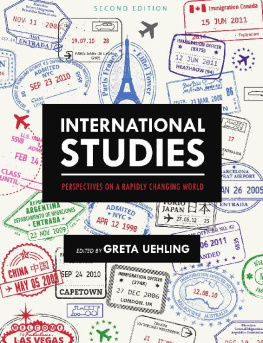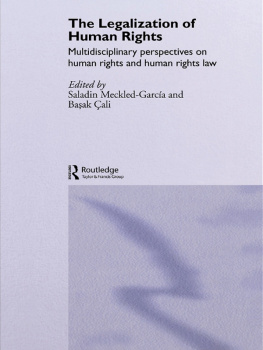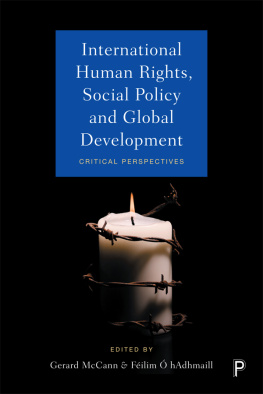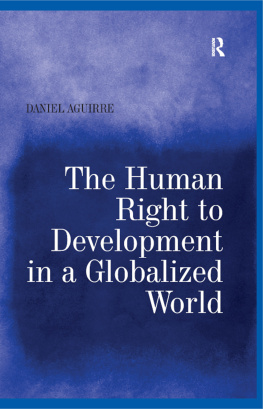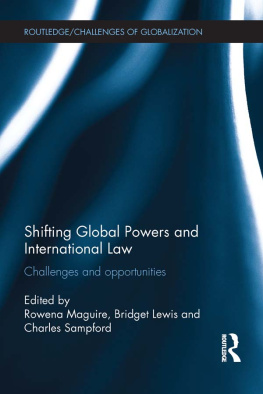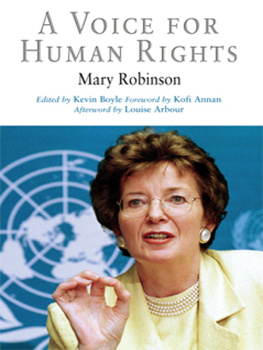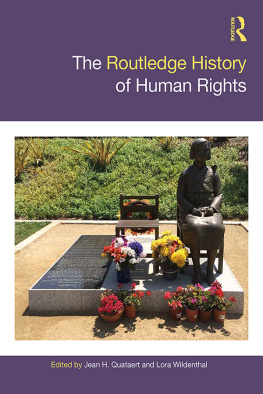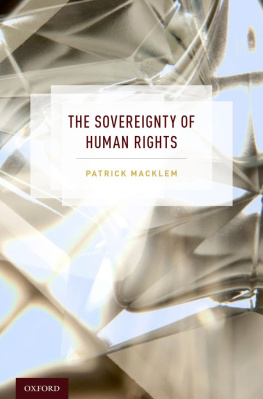REVISED SECOND EDITION
INTERNATIONAL STUDIES:
PERSPECTIVES ON A
RAPIDLY CHANGING WORLD
Edited by Greta Uehling
University of Michigan, Ann Arbor
Bassim Hamadeh, CEO and Publisher
Carrie Montoya, Acquisitions Editor
Kaela Martin, Project Editor
Jeanine Rees, Production Editor
Jess Estrella, Senior Graphic Designer
Alexa Lucido, Licensing Supervisor
Joyce Lue, Interior Designer
Natalie Piccotti, Director of Marketing
Kassie Graves, Vice President of Editorial
Jamie Giganti, Director of Academic Publishing
Copyright 2019 by Cognella, Inc. All rights reserved. No part of this publication may be reprinted, reproduced, transmitted, or utilized in any form or by any electronic, mechanical, or other means, now known or hereafter invented, including photocopying, microfilming, and recording, or in any information retrieval system without the written permission of Cognella, Inc. For inquiries regarding permissions, translations, foreign rights, audio rights, and any other forms of reproduction, please contact the Cognella Licensing Department at rights@cognella.com.
Trademark Notice: Product or corporate names may be trademarks or registered trademarks, and are used only for identification and explanation without intent to infringe.
Cover image copyright 2014 iStockphoto LP/Bubaone.
Printed in the United States of America.
ISBN: 978-1-5165-3849-2 (pbk) 978-1-5165-4521-6 (al) / 978-1-5165-3850-8 (br) / 978-1-5165-3851-5 (pf )
CONTENTS
What is International Studies?
v
Chapter One: Globalization
Seanon Wong. Whats in a Dumpling? The Chinese Fast-Food Industry and the Spread of Indigenous Cultures under Globalization in Stanford Journal ofEast Asian Affairs 17
Stanley Hoffmann. Clash of Globalizations in Foreign Affairs 27
Suzanne Staggenborg. Introduction
Chapter Two: International Organizations and Relations
Karen A. Mingst and Margaret P. Karns. The United Nations in World Politics
in United Nations in the 21st Century 53
John McCormick and Jonathan Olsen. Introduction in The European Union:Politics and Policies 67
Chapter Three: Human Rights and Humanitarianism
Claude Welch. The Universal Declaration of Human Rights at Sixty,
U.S. Department of State e-publications
Susan Waltz. Who Wrote the Universal Declaration of Human Rights?
U.S. Department of State e-publications
Eric Posner. The History of International Human Rights Law
in The Twilight of Human Rights Law 115
Antnio Guterres. Remarks to the General Assembly from the
United Nations 127
Jayshree Bajoria and Robert McMahon. The Dilemma of Humanitarian Intervention from the Council on Foreign Relations
iii
iv | International Studies: Perspectives on a Rapidly Changing World Chapter Four: Global Health and Environment
Debra DeLaet and David DeLaet. Key Concepts in Global Health in Global Health in the 21st Century: The Globalization of Disease and Wel ness 145
Scott Stonington. On the (F)utility of Pain in The Lancet 163
Scott Stonington. Whose Autonomy? in the Journal of theAmerican Medical Association
Regina Axelrod and Stacy Vandeveer. The Global Environment: Institutions, Law and Policy in CQ Press
Juliette Jowit. Bjrn Lomborg: The Dissenting Climate Change Voice Who Changed His Tune from The Guardian 191
Chapter Five: Human Development
Chimamanda Ngozi Adichie, The Danger of a Single Story
Andy Baker. Introduction: Underdevelopment and Diversity in the Global South in Shaping the Developing World: The West, theSouth, and the Natural World 205
United Nations Human Development Report 1990
Kennedy Odede. Slumdog Tourism from The New York Times
Chapter Six: Culture and Identity
Sarah Riley. Identity, Community, and Selfhood: Understanding the Self in Relation to Contemporary Youth Cultures
Amin Maalouf. In the Name of Identity: Violence and the Need to Belong
Benjamin Shingler. The Next Hot Sound? Powwow Step,
Aboriginal Hip-Hop from Al Jazeera America
Lila Abu-Lughod. Do Muslim Women Real y Need Saving?
Anthropological Reflections on Cultural Relativism and its Others
from American Anthropologist
What is International Studies?
In the past few decades, global interdependence has been increasing. This volume explores some of the many ways that people, ideas, capital, and technology flow across political, economic, and cultural borders, as well as perspectives on those flows. The interconnected quality of the world we live in suggests a strict disciplinary approach may no longer be ideal for understanding complex global problems. The field of international studies has developed to meet this challenge. It has evolved from a subtopic within political science into an interdisciplinary and comparative approach to questions of global significance. There is a closely related field you may have heard of, global studies, which focuses more on the role of race, class, and gender in international affairs. This closely related field places less emphasis on the importance of the nation-state. Both international and global studies are inspired by looking at the world from the perspective of different geographical areas and academic disciplines, and both fields are inspired to nurture the development of global citizens.
International studies is a relatively new field. The International Studies Association (ISA) has played a crucial role in the fields rapid growth and development. The ISA was formed in 1959 when scholars and practitioners saw a need for greater international and interdisciplinary dialogue (http://www.
isanet.org). The association continues to connect scholars and practitioners around the world and even has nongovernmental consultative status at the United Nations (http://www.isanet.org). The seven journals that the association publishes are valuable sources of information for students of international studies.1 This is a great time to be interested in international studies: individuals have never been as affected by events far from their homes as they are today.
International studies is a very broad field, and this volume can only provide an introduction. In spite of this breadth, there are some connecting themes that readers will find throughout the selections.
First, globalization, as a central and organizing concept, is explored from a different angle in each chapter. Human rights, human security, and human development are other key concepts you will take with you from the readings and links that follow. The first chapter on globalization will give readers a sense of the main debates about this central topic. Chapter two will explore international organizations and relations and relies predominantly on the discipline of political science. In chapter three, we 1 The journals students at the undergraduate level will find most helpful are The International Studies Review, InternationalStudies Perspectives, and Foreign Policy Analysis http://www.isanet.org/Publications/ISP.
v
vi | International Studies: Perspectives on a Rapidly Changing World consider two answers to the weaknesses of states and organizations: human rights and humanitarian-Image 0.1 Google Books Ngram Viewer
ism. Chapter four includes readings from the sciences as we consider global health and environment.
Human development came about in part to help solve issues of global health and environment and this is the topic of chapter five. The field of human development aspires to reduce inequalities within and between countries and enhance health and well-being for all people. The sixth and last chapter brings us back to the central problem of globalization with which we began the course: understanding continued cultural heterogeneity in spite of the homogenizing forces of globalization. In this chapter, we consider these tendencies from the perspective of refugees and indigenous peoples. As a whole, the volume aims to provide a clearer understanding of an increasingly international world; a better understanding of a selection of important international issues; and some conceptual tools that will help you analyze events long after your introduction to international studies.
Next page
